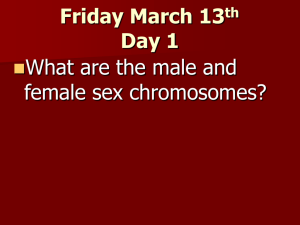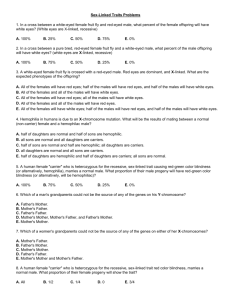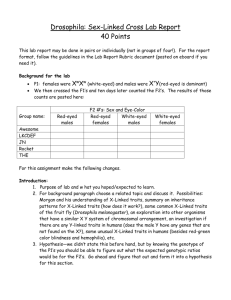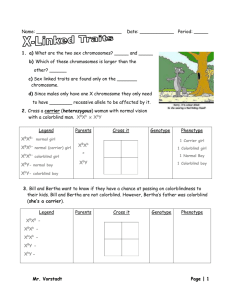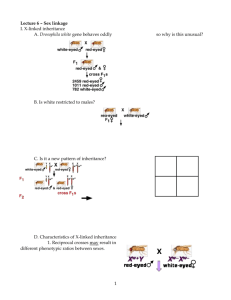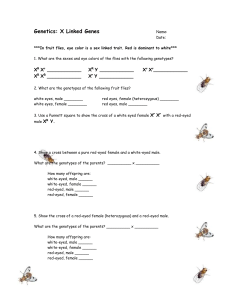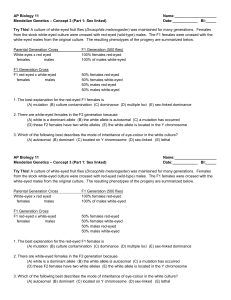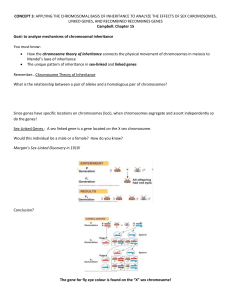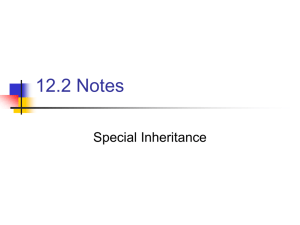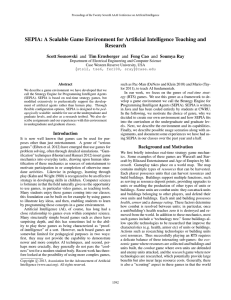Crosses to Complete for Lab #6
advertisement
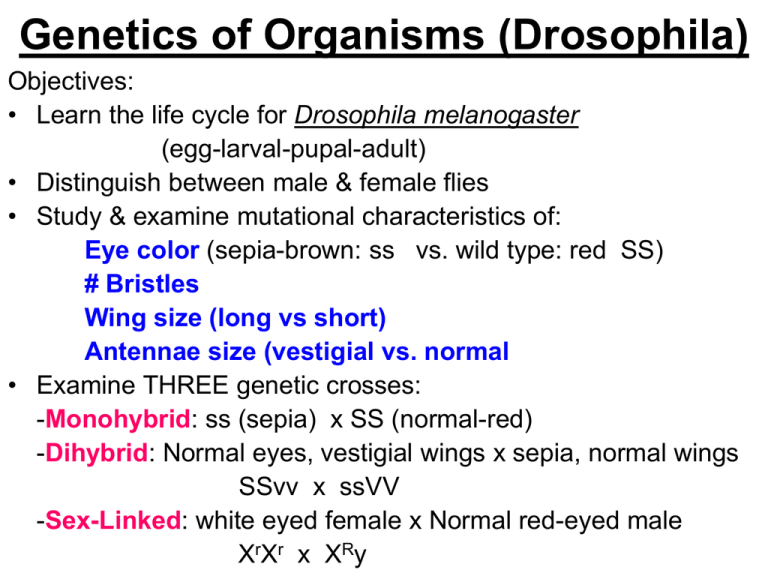
Genetics of Organisms (Drosophila) Objectives: • Learn the life cycle for Drosophila melanogaster (egg-larval-pupal-adult) • Distinguish between male & female flies • Study & examine mutational characteristics of: Eye color (sepia-brown: ss vs. wild type: red SS) # Bristles Wing size (long vs short) Antennae size (vestigial vs. normal • Examine THREE genetic crosses: -Monohybrid: ss (sepia) x SS (normal-red) -Dihybrid: Normal eyes, vestigial wings x sepia, normal wings SSvv x ssVV -Sex-Linked: white eyed female x Normal red-eyed male XrXr x XRy Why use Drosophila??? • • • • • • • • • Simple food requirements Occupies little space Hardy (survives well) Completes life cycle around 12 days (temp) Produces large numbers of offspring Easily immobilized (chilling on ice) to examine Several hereditary variations Small # of GIANT chromosomes (four pairs) Chromosomes easily located in the salivary gland cells Key Factors of this Lab • The flies live for about a month • Females will store up sperm in her receptacles & can continue to fertilize eggs • Virgins must be separated from males early on (distinguishing males & females) • Temperature is the most important factor that determines the length of life cycle Distinguishing between Male & Females Males – smaller – Dark, blunt abdomen – Sex comb on forelimb Females – Larger – Lighter pointed abdomen (ovipositer) – Transverse stripes on abdomen – No sex comb Table 7.1: F1 Generation Data (pg. 82) (Note: this page needs to be added to your packet) Phenotype and Symbol Red-eyed White eyed Females Males all XRXr all XrY **The table is larger than two rows. Don’t worry about the other rows, just leave them blank. F2 Generation: Sex-Linked trait (pg. 82) Table 7.2 F2 Generation Data Phenotype and Symbol Females Males Red-Eyed (XR) 78 XRXr 69 XRY White-Eyed (Xr) 62 XrXr 73 XrY Assume that the following Data was obtained and determine if it is significant by calculating a Chi-Square value. Do this in the margin space available on pg 82. Remember to calculate the expected (theoretical) values from the cross that produced the results above. The cross is written below. R r r (these came from F1 generation) X X x XY Red-Eyed heterozygous female crossed with white-eyed male Cross between two individuals from F1 Generation: XRXr x XrY r X R X R r X X Red-eyed female r X r r XX white-eyed female Y R X Y Red-eyed male r XY white-eyed Male 2nd Genetic Cross (pg. 83) • Red-Eyed: Dominant • Sepia eyes: Recessive (3) Parental cross: (3) F1 Cross: S s SS X ss (show a punnett square in box) Ss X Ss (show a punnett square in box) **Fill in this info. For #4 Table F1: F2: All Ss 3:1 (red:sepia) #5 There should be no deviations in the F2 results. Sometimes there could be fewer red-eyed individuals than expected and more individuals with sepia eyes. Data for Second Cross (Pg. 84) #6. The mutation will be Autosomal The mutation will be recessive The cross is monohybrid #7 Ss x Ss Phenotype # observed (o) # Expected (e) (o-e) (o-e)2 (o-e)2 e Red 140 Sepia 60 **Answer Questions “a” and “b” Page 85 • Answer Questions #1-3 based on the information written in the beginning of the lab. Other Crosses to do • Pgs 85-86: Green & Albino seedlings – Table 7.3 Gg x Gg Green Albino # Expected Calculate Calculate • Pg.88: Long & short winged flies **complete and calculate Chi-Square values to determine if the results are significant and acceptable (statistically valid) • Pg 89 Table 7.8
